Introduction

After a very long hiatus here’s my newest lens review, of the Nikkor AF 20mm f/2.8 D!
Many things have happened in my life recently, both personally and professionally, and because of the lack of time for “geeky” things such as testing and writing lens reviews, I have been spending most of my free time with my family – and obviously – taking photos of them. My favorite subjects have been my son and my wife 🙂

This was a big change in my “photography life”. Suddenly I wasn’t getting up early and spending an entire day outside taking landscape photos anymore, or simply walking around doing street photography or shooting insects… Now my priorities were two: portraits of my family and losing weight, well, not me but my photography gear.
I started the slimming program by dropping the heavy f/2.8 zooms and slowly substituting them with primes. At that time I also had a zoom lens which I liked a lot, the Nikkor AF-S 16-35mm f/4 G ED VR, which I regret not having the time to write a review of, and that had to go too. It wasn’t as heavy as the others, but it was nevertheless a long lens (and a speciality one which I used exclusively for landscapes). The slimming process went far: I still had the Nikon D700, one cheap zoom and two primes, but I added one new system to my kit: Micro Four Thirds, in my case an Olympus E-M10, two primes and the wonderful Olympus M.Zuiko 12-40mm f/2.8 PRO zoom lens. I spent several months shooting and filming with the Olympus, and the Nikon was sitting at home unused most of the time.
But everytime I decided to shoot with the D700, mostly portraits, it was magic. I simply could not abandon the full-frame format. Then I thought that it didn’t make much sense to keep shooting with the 12-40mm, since it was a lens that wasn’t very well balanced with the E-M10, and sold it for a new Olympus M.Zuiko 17mm f/1.8. Great lens, loved the rendering and AF speed, very compact and well built.

But I loved the look of full-frame… After some time I took the radical decision of selling all the Olympus gear and spent the money on the mighty Nikkor AF-S 58mm f/1.4 G lens. And what a treat is was! This is another lens I regret not writing a review of. It’s magic. I made so many beautiful portraits of my family with this lens, that I’m certainly we’ll admire them in the years to come. And now I don’t have this lens anymore, and why? Because I have migrated to a Sony A7s full-frame mirrorless camera, that’s why, and unfortunately there wasn’t any adapters that could AF with the 58mm, at least reliably. What a shame, I had to replace it somehow…
… but enough with the story and let’s get back to the Nikkor 20mm review!
This is a lens I never thought of buying when I had my D700, but now that I had a very small camera I needed small lenses, either native or adapted. Due to the lack of cheap ultra wide angle lenses for the Sony system, I had to look elsewhere for an adapted lens, and I saw the 20mm as a lens I was curious to try. So there it was at home, and even with the adapter it makes a nice combo with the Sony A7s:


This lens was announced in 1994 and is still being produced today, despite the release of the new Nikkor AF-S 20mm f/1.8 G and the now “ancient” aperture ring. It’s still the smallest ultra wide lens for the Nikon mount an can be bought cheaply today on the used market for about 300€.
Technical Specifications
| Focal length | 20mm |
| Maximum aperture | f/2.8 |
| Minimum aperture | f/22 |
| Field of view | 94 degrees (on FX) |
| Weight | 270g |
| Dimensions | 43 x 69mm (46 x 69mm at minimum focus distance) |
| Optical construction | 12 elements in 9 groups |
| Aperture blades | 7, straight |
| Filter diameter | 62mm |
| Minimum focus distance | 25cm |
| Hood | HB-4, optional |
| Mount | F |
Mechanical Characteristics
| Zoom ring | n/a |
| Focus ring | Plastic with rubber finish, with infinity stop |
| Focus throw | 93 degrees |
| Focus motor | No |
| Optical stabilizer | No |
| Front element rotation while zooming | n/a |
| Front element rotation while focusing | No |
| Internal focusing | No |
| Lens extension while focusing | Yes, 3mm |
| Lens extension while zooming | n/a |
| Maximum magnification | 1:8.3 |
Handling
The lens is very well built, and despite being all plastic on the outside it gives a very solid, dense feeling due to its weight and compactness. Since it’s so small even with the adapter, handling it with the Sony A7s is very easy and manual focus is nice for an AF lens. There’s a generous focus throw and, being an ultra wide lens, focusing is very easy. A nice bonus is the hard stop at infinity, just like the old AI lenses!
The front element doesn’t rotate while focusing, so using polarizers is not a problem.
Resolution
For the resolution test I shot two different targets, one sitting around 1 meter from the lens, and the other at “infinity”.
In both results, the first column shows a crop of the image center, and the second column shows a crop of the extreme corner. Each row represents an aperture setting, from maximum to f/22 in full stops.
Here are the results, first at the close target:

The center resolution is already on its maximum value, which I was kind of expecting from my experience with other old lenses, and only drops at f/22 due to diffraction. The corners, though, are a completely different matter; they start rather bad at f/2.8 and aggravated with huge vignetting, and resolution doesn’t improve much at f/4. Only at f/5.6 one starts to see sharp corners on full frame, but the very best apertures are f/8 and f/11 for homogeneous resolution corner to corner. Once again this is in line with the resolution characteristics with other old wide angle lenses, such as the 24mm and 28mm f/2.8 lenses.
When the target is located far away, the result is a little different:

The main difference is what happens at f/2.8 in the center. It’s very soft, and the corners are equally bad. But by f/4 there’s a big jump in quality in the center, despite the corners still being a little soft. Afterwards the behavior resembles what happened with the close target, but resolution in the corners is still rather soft even at f/5.6. Then, from f/8 and until f/16 the corners become very sharp and overall resolution only drops at f/22 because of diffraction.
Overall, this is still a great performance for an ultra wide angle lens and the resolution results are great for landscape photography when stopping down the aperture is the norm.
Distortion
Not a brick wall, but this image allows to see the distortion characteristics of the lens:

The lens has very visible barrel distortion along with a mustache type characteristic, producing a very wavy shape to horizontal lines, and because of that should be used with care in architecture photography, especially regarding horizontal lines. For landscapes this is not very important unless there are things like horizon line on seascapes, and in this case the distortion characteristic might be hard to fix, but using the appropriate profile for this lens in post-processing does the trick with one click.
Vignetting

Vignetting is very strong at f/2.8 and affects the entire frame, making the center lose about 1/3 stops of light, but the corners get really dark. At f/4, falloff improves drastically but the corners are still very dark. Vignetting never goes away afterwards until f/16, and only at f/22 there’s finally an improvement. However, vignetting is very easy to correct in post-processing and shouldn’t present a real issue in most circumstances.
Chromatic aberrations

I couldn’t force the appearance of CAs whatever I did. Even at f/2.8 I could not see any traces of fringing, it’s really great.
Coma
Coma was tested using a LED source, at home in a dark room.
The three columns in the following image show the result at the center, APS-C corner and full-frame corner, respectivelly:
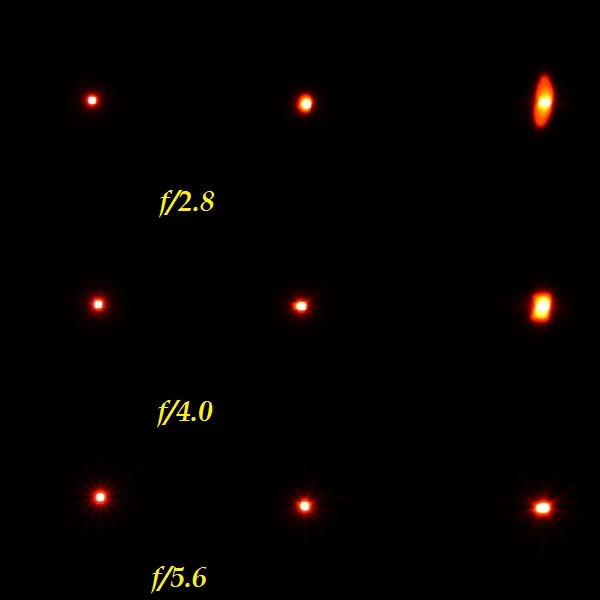
As expected for a relatively fast ultra wide angle lens, coma is very high in the corners at full aperture. This is normal and difficult to correct during manufacturing, and is impossible to fix in post-processing. In this matter, the lens disappoints for applications like astrophotography where negligible coma distortion is crucial.
Flare
For the flare test, I started shooting directly against the sun, then placed the sun at the corner and finally made shot with the sun just outside the frame.
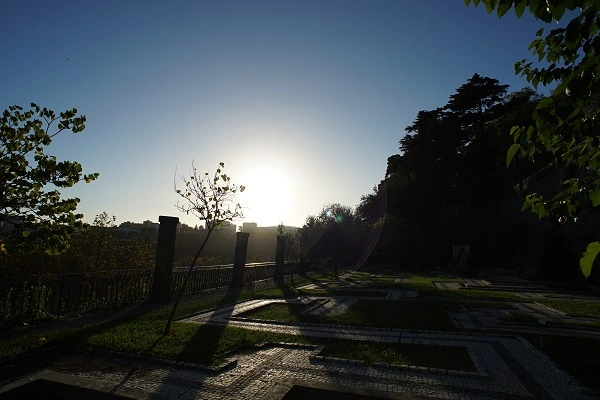 |
| Shot directly against the sun. |
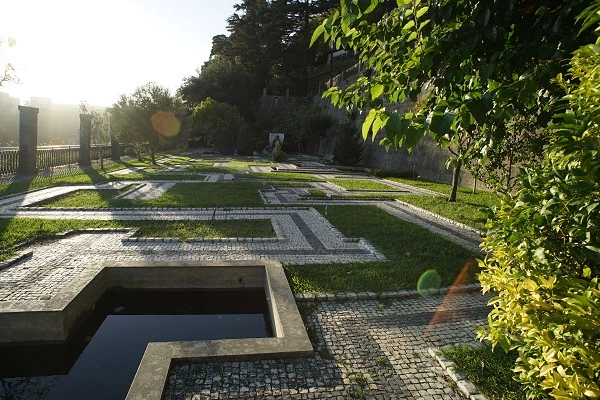 |
| Shot with the sun placed at one corner of the frame. |
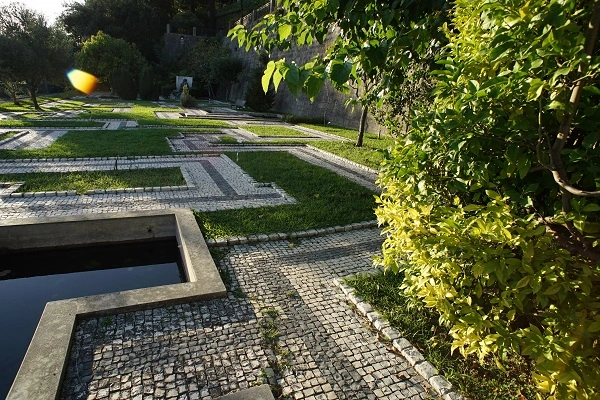 |
| Shot with the sun just outside the frame. |
The lens has a very good resistance to veiling flare which is important to keep contrast high. The problem is that if the sun is in the frame or in the proximity, the internal reflections of light will be easily visible in the pictures, as tiny as those reflections may be. This characteristic is normal for old wide angle lenses, and the more the angle the worse ghosting becomes.
In conclusion, the best thing to do is leaving the sun at a safe distance from the frame.
Bokeh
This is a wide focal lens with 7 straight blades, thus bokeh has to be the last thing you think about when buying this lens.
This test is based on a defocused picture of the city lights and getting crops from the center and corner at three different apertures.

The lens produces a reasonable bokeh wide open, not in this test because of the very visible accentuated edges, but when the background has lower contrast areas. In real life shots, bokeh is not very distracting, though. Stopping down immediately shows polygonal shapes which are the result of the straight type diafragm blades. However, this is in line with every ordinary wide angle lenses I tested.
Macro/Close-up
This lens employs CRC (Close-Range Correction) technology by means of floating elements that help correcting optical problems when focusing very close. As a result, this lens has a very sharp center wide open at the minimum focus distance. This allows to focus as close as 25 centimeters from the front plane, resulting in a maximum magnification ratio of 1:8.3. It’s not bad, but I’ve seen much better from other (modern) wide angle lenses.
I shot a Sony battery and this is the entire frame at the minimum focus distance:
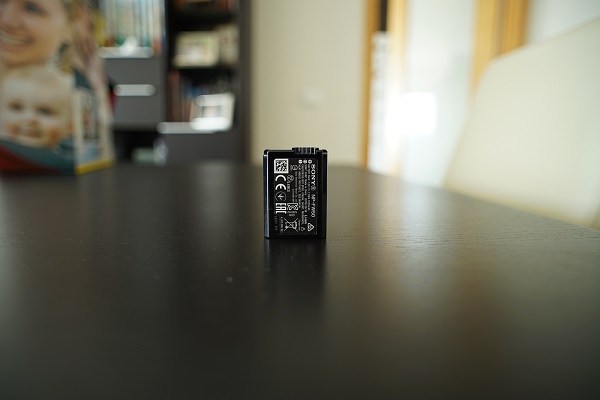
Summary
| Build quality | 7 | All-plastic on the outside but very solid, dense feeling |
| Handling | 7 | Easy manual focusing and aperture selection with the ring |
| Resolution | 8 | Very good resolution for an ultra wide angle lens, but wide open good only at short distances |
| Distortion | 5 | Complex barrel and mustache distortion, not suitable for architecture |
| Vignetting | 4 | Very strong wide-open, and always there afterwards |
| Chromatic aberrations | 10 | Perfect, no issues here |
| Coma | 7 | Very noticeable in the borders wide open, well controlled afterwards |
| Flare | 7 | Contrast is always high but ghosts are too easy to catch with the sun nearby |
| Bokeh | 4 | Just acceptable wide-open |
| Overall | 65% | A sharp and very compact ultra wide angle prime lens, still a great buy today especially on the used market for mirrorless cameras |
Samples
Here are some samples of pictures I made with this lens. Settings: native JPEG, picture control set to Standard mode, no post-processing applied except reducing to 600 pixel width.
 |
 |
 |
 |
 |
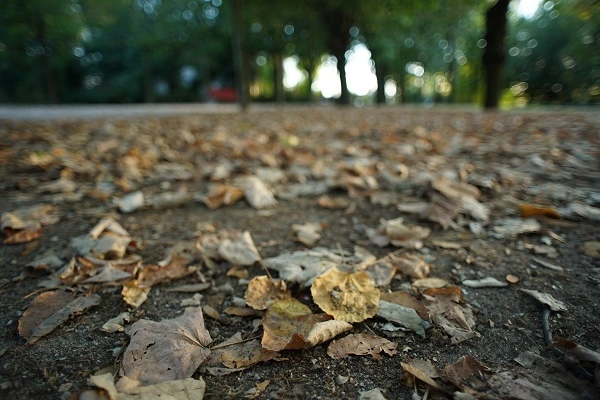 |